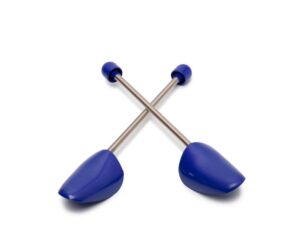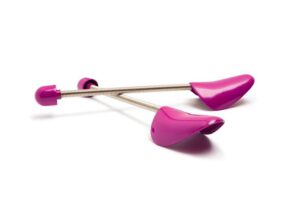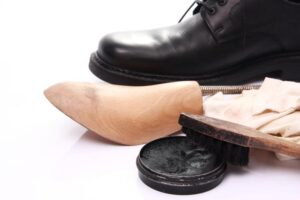Although spiral shoe trees are a popular choice among many shoe enthusiasts, they may not be the most effective option for preserving the integrity of your beloved footwear. Investing in quality shoes is significant, and using the wrong type of shoe tree can result in irreversible damage. While spring-loaded shoe trees seem convenient, their design exerts harmful vertical pressure, which can distort the upper leather and jeopardize the heel stiffener. In contrast, premium wooden shoe trees provide gentle horizontal support, effectively maintaining the original shape of your shoes while significantly prolonging their lifespan. Adopting this simple yet impactful change in your shoe care routine can be vital for preserving your cherished footwear for many years ahead.
Recognizing the Dangers Associated with Spiral Shoe Trees
To effectively protect your shoes from unnecessary harm, it is crucial to understand the potential risks tied to spiral shoe trees. These commonly used shoe care tools are present in 80% of households that utilize shoe trees, yet they can unwittingly damage the structure and shape of your footwear over time. Recognizing these risks enables you to make knowledgeable decisions regarding your shoe maintenance practices, helping you avoid costly mistakes in the long run.
Highlighting the Design Limitations of Spiral Shoe Trees
Alarmingly, 90% of spiral shoe trees feature a “one size fits all” design, leading to suboptimal fit and insufficient support for your footwear. This generic approach fails to accommodate the unique contours and dimensions of your shoes, rendering them ineffective in preserving the shoe's intended form. The absence of customizability can ultimately contribute to unnecessary wear and tear, potentially shortening the lifespan of your favorite pairs.

Understanding Pressure Points and Their Detrimental Impact
The use of spiral shoe trees creates the risk of developing harmful pressure points within your shoes. The metal spring exerts an upward force against the vamp area, while the small rear component applies concentrated pressure on the heel stiffener. This uneven distribution of force can lead to substantial issues over time.
Furthermore, prolonged reliance on spiral shoe trees may lead to permanent deformation of your footwear. The vertical pressure they exert can damage the welt stitching and cause the leather to bulge, ultimately altering its intended shape. You may start to notice these adverse changes as quickly as three to six months of regular use, highlighting the importance of selecting the right shoe care solutions.
How Spiral Shoe Trees Undermine the Structure of Your Footwear
Utilizing spiral shoe trees can inflict serious damage to the structural integrity of your shoes. The uneven pressure distribution coupled with the continuous strain from the spring mechanism can lead to permanent deformation, negatively impacting both the upper leather and the internal support components of your footwear.
Assessing Vamp Area Deterioration and Its Consequences
The detrimental impact on the vamp area is particularly concerning, as spiral shoe trees unnaturally push the upper leather upwards. This upward force can distort the original shape of your shoes and potentially damage the welt stitching, leading to premature wear and an increased risk of sole separation, compromising the longevity of your footwear.
Examining Heel Stiffener Damage Risks
Behind the scenes, the heel stiffener experiences concentrated pressure from the small tail piece of spiral shoe trees. This pressure can cause the heel area to bulge, especially in shoes equipped with leather or leather board stiffeners, ultimately altering the original heel shape and comfort level.
Moreover, damage to the heel stiffener can often be irreversible. The continuous pressure from spiral shoe trees can lead to deformation of up to 50% more than its original shape, as documented in various cases involving RM Williams boots. This deformation not only compromises comfort but also significantly reduces the lifespan of your footwear, making the choice of shoe care products critical.
Dispelling Common Misconceptions Surrounding Shoe Care Practices
Despite their widespread use, spiral shoe trees can actually cause serious damage to your footwear. Many people assume that these devices retain shoe shape effectively, but in reality, they often create harmful pressure points, leading to permanent distortion of the leather and the overall structure of the shoe.
Challenging the One Size Fits All Fallacy
One of the most significant mistakes you can make is believing that generic spiral shoe trees will fit all your shoes appropriately. These products typically come in just one or two standard sizes, which means they cannot provide the tailored support your shoes require. This universal approach can lead to uneven pressure distribution and potential damage that could have been easily avoided with the right shoe care tools.
Weighing Price Against Quality for Shoe Care Products
Just because a product fits within your budget does not mean it will fit your shoes well. Although spiral shoe trees may seem like an affordable option, their low price often reflects inadequate design, which can cause up to 70% more damage to your footwear compared to properly sized wooden shoe trees that are designed for optimal care.
When considering costs, it is vital to account for long-term expenses. Using spiral shoe trees can reduce your shoes’ lifespan by 40%, leading to more frequent replacements and greater overall expenses. Quality wooden shoe trees may require a higher upfront investment, but they offer superior shape retention and help preserve the original form of your footwear, ultimately saving you money in the long run.

Determining the Essential Characteristics of Quality Shoe Trees
Many shoe trees on the market today fall short in delivering adequate support for your footwear. The ideal shoe tree should feature anatomically correct shapes that align with your shoe’s natural form. It’s essential to have distinct left and right trees, with proper width adjustability and designs that maintain your shoe’s original shape without exerting excessive pressure, ensuring a better fit.
Emphasizing Horizontal Stretching Properties for Shoe Trees
Between the toe and heel regions, your shoe tree should promote a gentle horizontal stretch rather than applying vertical pressure. It is vital for the tree to evenly distribute the width of your shoes, effectively preventing creases while preserving the leather’s natural shape. This horizontal force is crucial for maintaining the vamp area without damaging the delicate welt stitching.
Ensuring Proper Volume Distribution for Optimal Support
The design of your shoe tree should prioritize even volume distribution throughout your shoe. Adequate support must be provided in the toe box while ensuring gentle pressure along the sides. The heel area requires careful support without excessive force, which could jeopardize the heel stiffener or distort your shoe’s original shape, leading to long-term issues.
Effective pressure distribution is a fundamental aspect of shoe tree functionality. Your shoe trees should fill 80% of your shoe’s volume while avoiding concentrated pressure points. This balanced approach aids in moisture absorption and shape retention without risking damage to the leather or construction elements of your shoes.
Exploring Superior Alternatives for Comprehensive Shoe Care
For optimal shoe maintenance, it's essential to explore effective alternatives to spiral shoe trees that will protect your footwear’s shape and extend its lifespan. The right shoe tree should distribute pressure evenly and provide natural support without causing damage to the leather or stitching, ensuring your footwear remains in excellent condition.
Highly Recommended Shoe Tree Types for Maximum Protection
- Cedar wood shoe trees – naturally absorb moisture and help prevent odors
- Split-toe designs – offer adjustable width for a superior fit tailored to your shoes
- Full heel support – ensure proper back shape maintenance for longevity
- Anatomically correct forms – designed specifically for left and right shoes, enhancing fit and function
| Feature | Benefit |
|---|---|
| Cedar Material | Absorbs moisture and prevents unpleasant odors, ensuring freshness |
| Split-toe Design | Offers customizable width adjustment for a better fit and comfort |
| Full Heel Block | Maintains the integrity of the heel shape for prolonged shoe life |
| Anatomical Shape | Preserves the natural form of your shoes, preventing distortion |
| Even Pressure | Helps prevent any distortion of the leather, enhancing durability |
Essential Guidelines for Proper Shoe Tree Usage
When inserting shoe trees, it is best to do so immediately after wearing your shoes while they remain warm. This practice helps maintain the original shape as the leather cools and prevents unwanted creasing, which can be detrimental over time. Ensuring the shoe trees fit appropriately is crucial; avoid applying excessive pressure. Keep them in for at least 24 hours after use to allow ample time for moisture evaporation and shape retention. The shoe trees should occupy the shoe volume naturally without stretching or distorting the leather, ensuring optimal care.
Making Informed Investments in Shoe Care Practices
Having understood the dangers posed by spiral shoe trees, it’s time to shift focus towards making informed investments in your shoe care practices. Quality shoe trees can protect footwear worth hundreds or even thousands of dollars, making them an indispensable part of your shoe care routine. The choice of shoe trees significantly impacts the longevity and appearance of your shoes.
Emphasizing Long-term Shoe Care Strategies
Contrary to popular belief, spiral shoe trees can harm your expensive footwear by creating unwanted pressure points. Investing in robust wooden shoe trees that distribute pressure evenly across the shoe will help maintain its original shape and extend its lifespan by several years, offering greater value for your investment.
Evaluating Cost-Benefit Analysis for Shoe Tree Purchases
The long-term savings associated with using proper shoe trees far outweigh their initial purchase cost. While spiral shoe trees might be priced between $10-15, quality wooden shoe trees costing $30-50 can save you hundreds of dollars in shoe damage. Investing in the right shoe trees is an effective way to safeguard your footwear investment and ensure your shoes remain stylish and functional.
While the temptation to save money with cheaper spiral alternatives may be strong, consider this: proper wooden shoe trees can prevent heel distortion, maintain leather integrity, and preserve shoe structure. By investing wisely, you’ll spend less on shoe repairs and replacements over time. The numbers are clear – investing in quality shoe trees now will lead to significant savings on shoe replacements in the future.

Key Insights for Effective Shoe Care
In summary, it is essential to avoid spiral shoe trees due to their potential to harm your shoes through incorrect pressure distribution and inadequate design. Instead, investing in solid wooden shoe trees tailored to your shoe size and shape is crucial. These trees will protect your shoes by offering horizontal support while maintaining their original shape. Opt for cedar or beech wood shoe trees with adjustable width and appropriate toe shapes. This simple change in your shoe care routine can significantly enhance the preservation of your shoes’ structure and extend their lifespan.
Answers to Common Questions about Shoe Care
What makes spiral shoe trees harmful to shoes?
Spiral shoe trees pose a threat to shoes primarily for two reasons. They push the leather upwards at the vamp area, resulting in damage to the shoe’s shape and potential harm to the welt stitching. The small back component also applies excessive pressure to the heel stiffener, which can lead to permanent deformation in that area. These issues arise because spiral shoe trees exert pressure in incorrect directions, unlike proper shoe trees that operate horizontally.
Which type of shoe trees should I select instead of spiral options?
Opt for solid wooden shoe trees designed with an anatomical shape that specifically matches your shoe size. Quality shoe trees should include a full heel piece rather than just a small tail section and should stretch the shoes horizontally instead of vertically. They should fill the shoe’s volume uniformly without applying excessive pressure to any particular area. Split-toe designs are particularly effective, as they allow for adjustable width for a better fit, ensuring maximum care.
If I only have spiral shoe trees available, what can I do?
If spiral shoe trees are your only option, consider using them without bending the spring (keeping the back part out) or refrain from using shoe trees altogether. Utilizing no shoe trees is less harmful than improperly using spiral ones. However, the best course of action is to invest in proper wooden shoe trees that will effectively help maintain your shoes’ shape and prolong their lifespan.
The Article Why you should avoid using spiral shoe trees and what to use instead appeared first on My Shoes Finder
The Article Avoid Spiral Shoe Trees: Discover Better Alternatives Was Found On https://limitsofstrategy.com


Your insights on the risks associated with spiral shoe trees really resonate with me, particularly as someone who has invested in quality footwear over the years. I’ve often found myself caught in the tug-of-war between convenience and the best care practices for my shoes. Early on, I eagerly purchased spiral shoe trees thinking they were the go-to solution for maintaining my shoes, since they seemed straightforward and widely recommended. However, after some time, I started noticing subtle changes in the shape of my favorite pair, which prompted me to reconsider my choices.
It sounds like you’ve had quite the journey with your shoes, and I can relate to that struggle between convenience and proper care. It’s interesting how something that seems so straightforward, like using spiral shoe trees, can lead to unintended consequences down the line. I’ve also found myself falling for popular solutions that aren’t quite right for my needs.
It really is fascinating how something as simple as shoe care can turn into a bit of a dilemma. I can relate to that struggle too—balancing the convenience of quick fixes with the long-term benefits of investing in proper care. I used to think all shoe trees were essentially the same, but I learned the hard way that the specific materials and design really matter.
You raise an interesting point about the complexities of shoe care, and it’s one I think many people overlook until they’re knee-deep in worn-out footwear. The temptation to go for the quick fix is strong—whether it’s a can of spray or a cheap pair of shoe trees—but that convenience often masks what’s really at stake. Investing in the right tools, like quality shoe trees, really can make a world of difference, not just in the lifespan of your shoes but in the overall experience of owning them.
It’s interesting how many of us find ourselves navigating that delicate balance between wanting to take great care of our shoes and the everyday realities of convenience. The journey of learning the best methods for shoe care often feels like a winding road, doesn’t it? Your experience with spiral shoe trees resonates deeply, especially since so many consider them an essential tool for maintaining the integrity of their footwear.